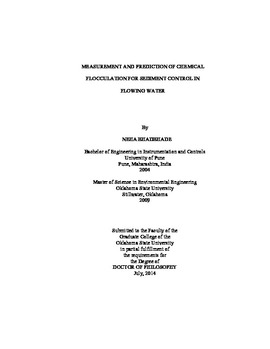| dc.contributor.advisor | Vogel, Jason R. | |
| dc.contributor.author | Bhadbhade, Neha | |
| dc.date.accessioned | 2015-06-17T20:04:53Z | |
| dc.date.available | 2015-06-17T20:04:53Z | |
| dc.date.issued | 2014-07 | |
| dc.identifier.uri | https://hdl.handle.net/11244/14728 | |
| dc.description.abstract | Land disturbance activities on construction sites can increase the rate of soil erosion at alarming rates, especially during intense storm events. Freshwater streams receiving the sediment laden runoff can experience adverse ecological effects due to depleting oxygen levels caused by deposition of excessive sediment in them. Most conventional sediment control techniques like silt fence, sedimentation basin and check dams can remove sand and large aggregates, however they are ineffective in removal of clay particles, which remain in suspension for longer duration and are the primary source of turbidity. Therefore, flocculation can be used to increase the settling rate of the clay particles. Currently, flocculant treatment is often applied on a trial and error basis on construction sites. The goal of this research is to develop a process-based approach to measure and predict the flocculation of sediment in stormwater runoff The specific research objectives were: (1) To conduct flume experiments on five soils from Oklahoma to measure the flocculation efficiency; (2) To use a mathematical modeling to predict the flocculation efficiency for those five soils using polymer flocculant and perform a sensitivity analysis on the mathematical model; and, (3). To characterize the turbulence within a jar test apparatus through similitude studies. The flume investigations were utilized to characterize flocculation both spatially and temporally for different soil types. The uniqueness of the apparatus and the experiment procedures allowed the control of the input variables, yet allowed for the simulation of suspended sediment distributions in the flow similar to those observed in construction site runoff. A flocculation model was developed to predict flocculation efficiency for different soil types using chemical flocculant. The calibrated model predicted flocculation removal efficiency for the flume runs for four of the five soils investigated. Spatial and temporal turbulence measurements were used to characterize the floc distribution within a jar-test apparatus, which has the potential to improve the laboratory estimation of flocculation efficiency for many applications. The flocculation measurement methods and model developed by this research are useful tools for predicting sediment removal from stormwater runoff and for optimizing the design of sediment control systems that utilize flocculation. | |
| dc.format | application/pdf | |
| dc.language | en_US | |
| dc.rights | Copyright is held by the author who has granted the Oklahoma State University Library the non-exclusive right to share this material in its institutional repository. Contact Digital Library Services at lib-dls@okstate.edu or 405-744-9161 for the permission policy on the use, reproduction or distribution of this material. | |
| dc.title | Measurement and prediction of chemical flocculation for sediment control in flowing water | |
| dc.contributor.committeeMember | Storm, Daniel | |
| dc.contributor.committeeMember | Brown, Glenn | |
| dc.contributor.committeeMember | Wilber, Gregory | |
| osu.filename | BHADBHADE_okstate_0664D_13627.pdf | |
| osu.accesstype | Open Access | |
| dc.type.genre | Dissertation | |
| dc.type.material | Text | |
| dc.subject.keywords | construction site | |
| dc.subject.keywords | flocculation | |
| dc.subject.keywords | stormwater runoff | |
| dc.subject.keywords | suspended sediment | |
| dc.subject.keywords | turbidity | |
| thesis.degree.discipline | Biosystems and Agricultural Engineering | |
| thesis.degree.grantor | Oklahoma State University | |
